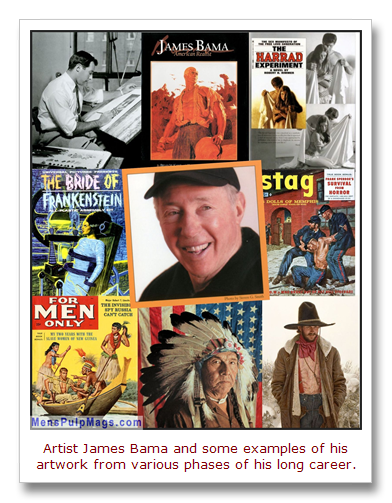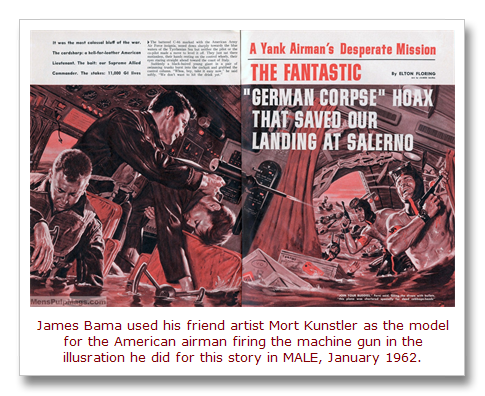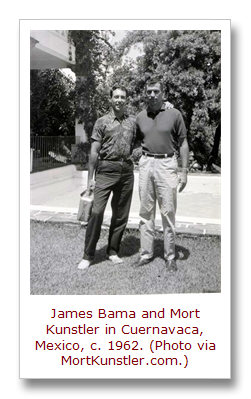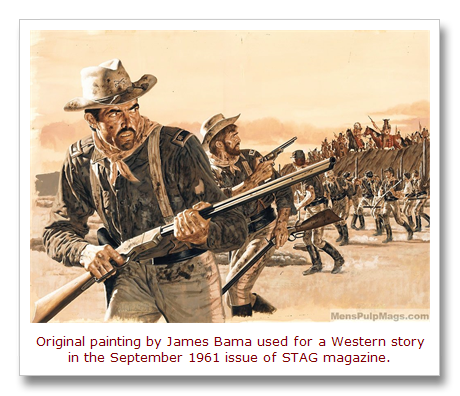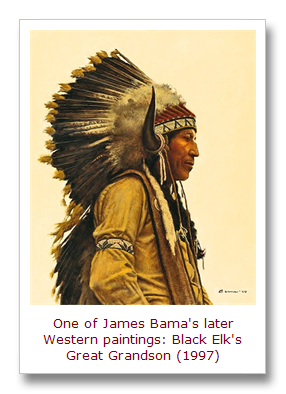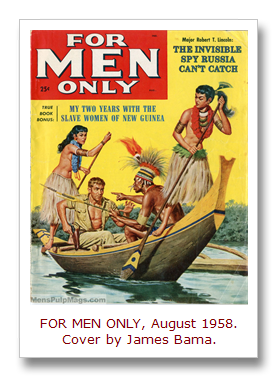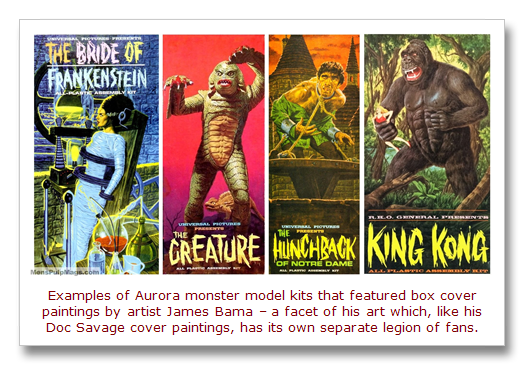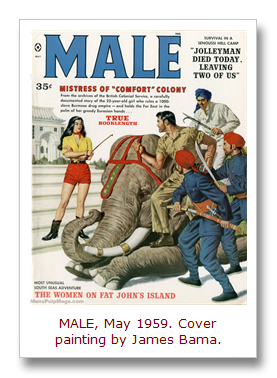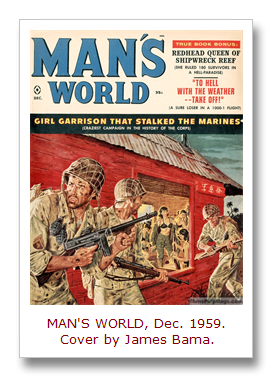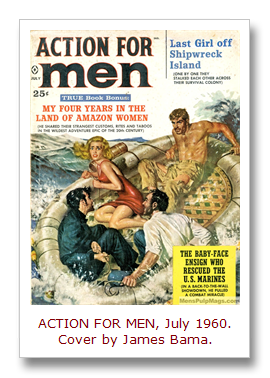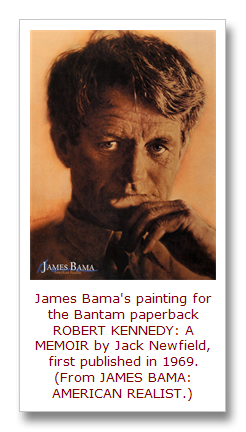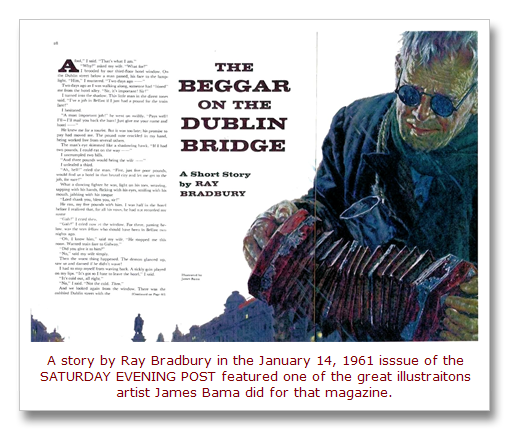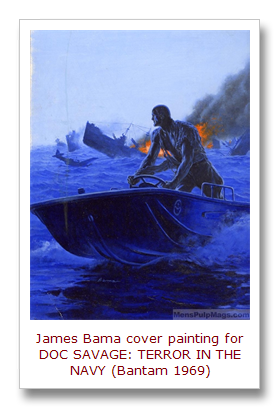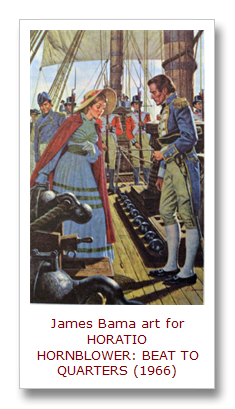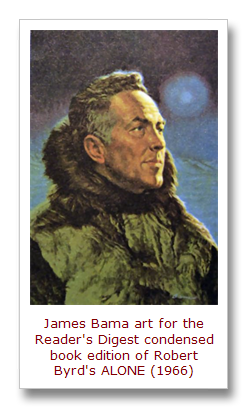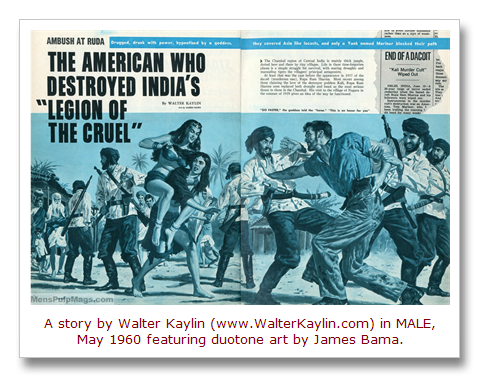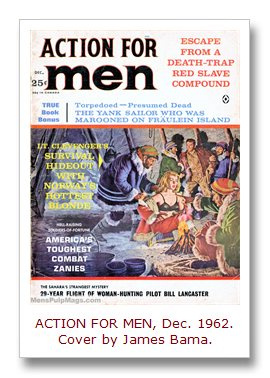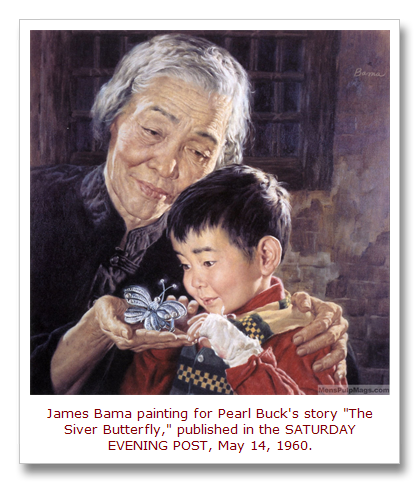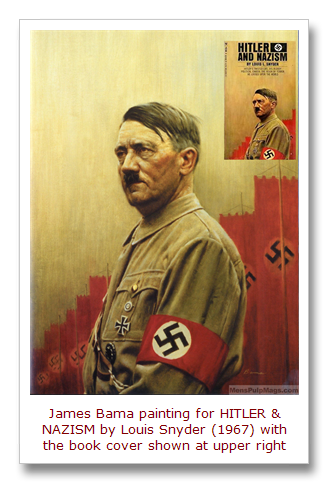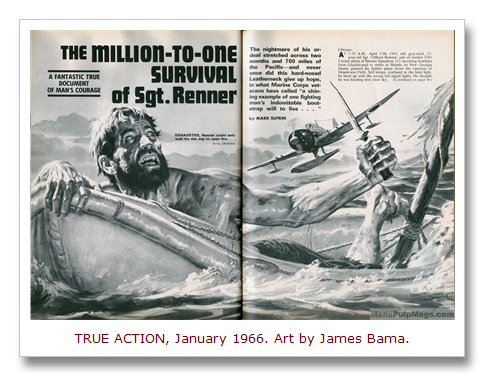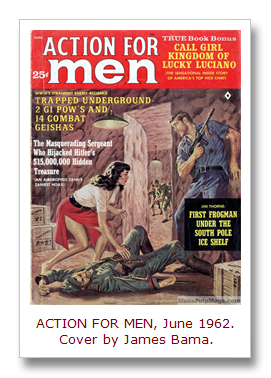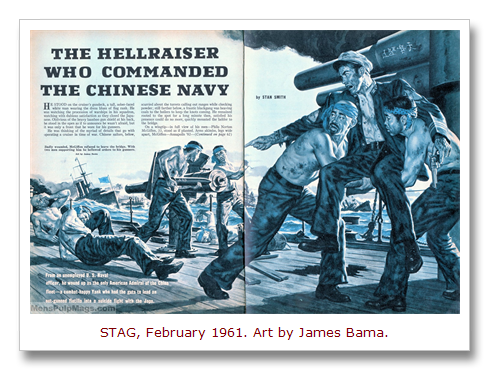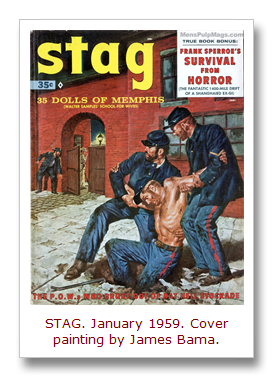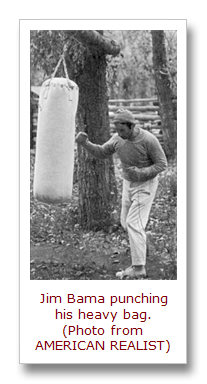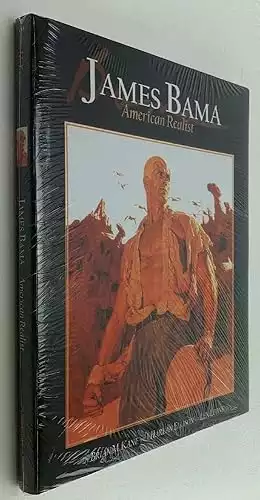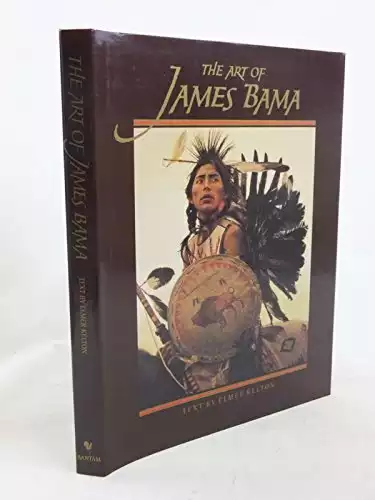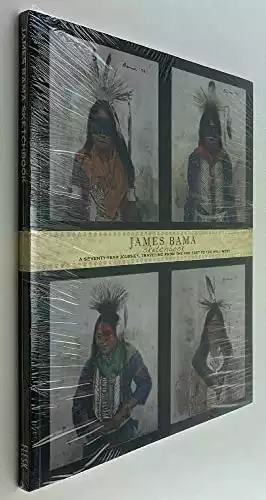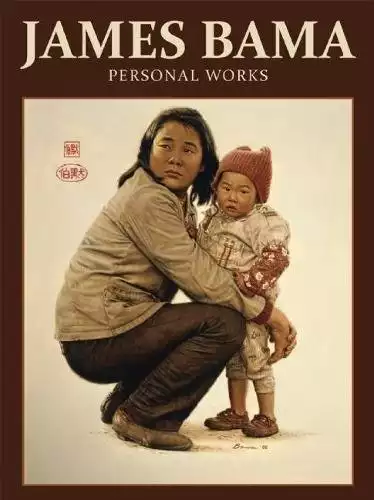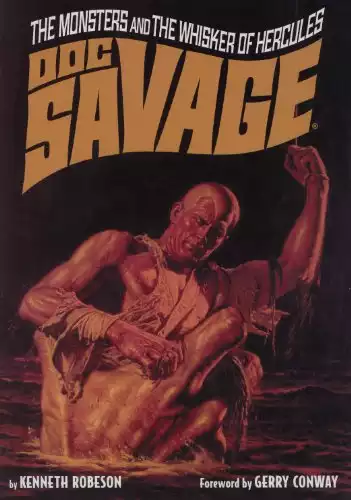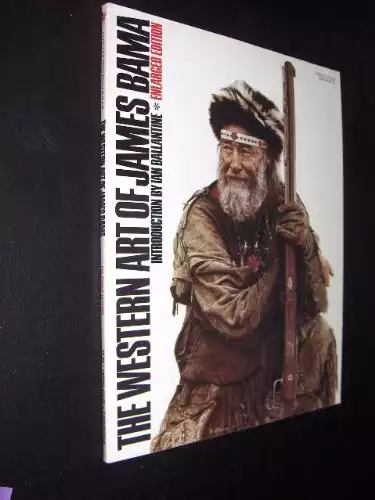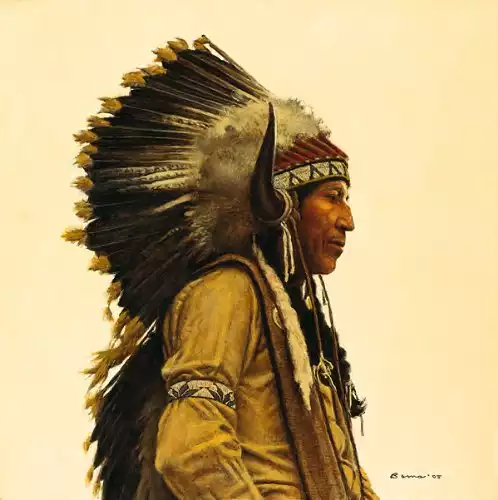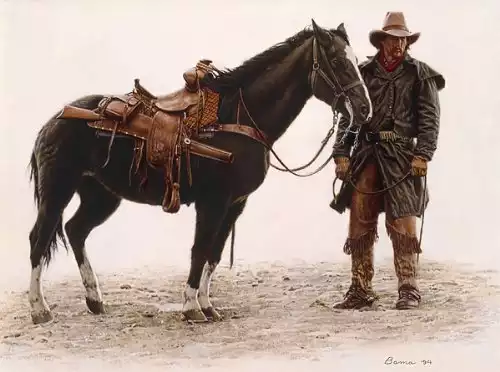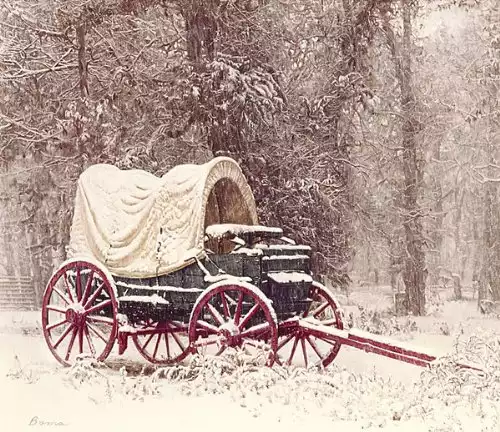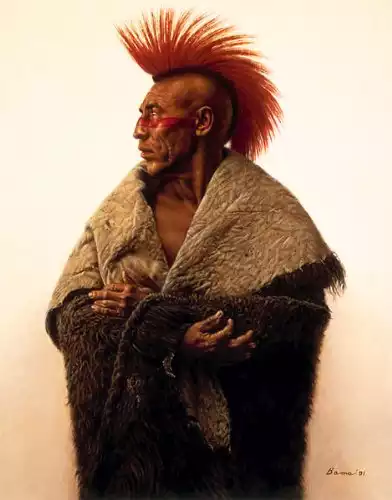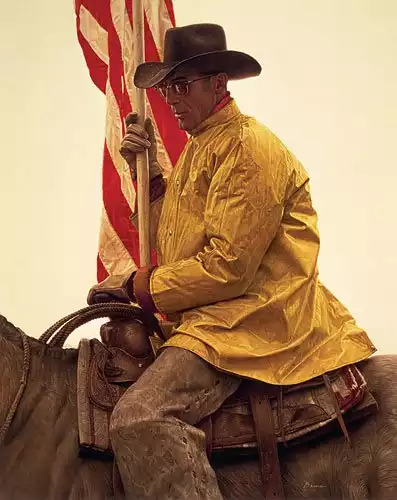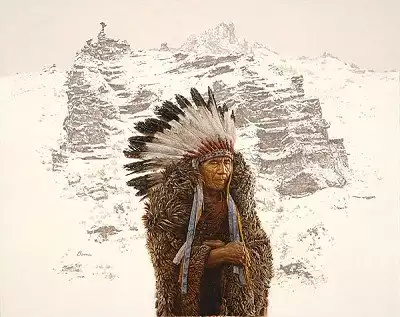Toward the end of Part 2 of my interview with artist James Bama, we discussed one of the classic men’s adventure magazine illustrations he painted that’s featured in the must-have book about him, JAMES BAMA: AMERICAN REALIST.
It’s a duotone that was used in the January 1962 of MALE for the story titled “THE FANTASTIC ‘GERMAN CORPSE’ HOAX THAT SAVED OUR LANDING AT SALERNO”
Jim told me his great friend Mort Kunstler, who also worked for men’s adventure magazines in the 1950s and 1960s, posed as the model for American airman firing the machine gun in that illo.
As Jim noted, there’s a quote about him by Mort Kunstler on the page in AMERICAN REALIST that shows the painting…
MensPulpMags.com editor Bob Deis: I looked up that quote about you by Mort while we were talking…
James Bama: He wrote a very nice thing.
Definitely. He said: “Jimmy and I first met in the 1950s, in Magazine Management’s waiting room and it wasn’t long before we became best of friends. Once a week I’d go in to New York for assignments, have lunch or dinner with Jimmy, and we’d go to the Westside ‘Y’ to play basketball.”
Bama: Mort was a great athlete. He was a great basketball player. He was a track star and I think he was a swimmer or a diver. He used to play basketball with Dick McGuire, who was the star of the New York Knicks and Mort was better than him. When we went up to the YMCA he just wiped everyone out. I was a pretty good basketball player, but he’d beat me like 10 baskets to 3. Mort was a great athlete, a great athlete.
Mort also said in that quote: “Jimmy was one of the hardest working guys I knew. His technique was overwhelming and he became one of the best artists in the field. At a party in 1961, before I moved to Mexico, I introduced Jimmy to Len Leone, which started his career with Bantam Books. I have very fond memories of those days.”
Bama: Oh, yeah, we were great friends for years. I knew his whole family. I visited them in Mexico when he moved there for a while in the the early 1960s. He wanted his kids to experience a different culture. So, I went down to visit him, and some of the paintings in my latest book [JAMES BAMA: PERSONAL WORKS] were based on things I saw in Cuernavaca where he lived.
I did an interview with Mort a while back and he told me that, in addition to linking you up with Bantam Books, which led to the Doc Savage paperback covers that became one of the best-known facets of your career, he also got you your first job doing box cover art for the Aurora monster model kits, which you’re also famous for.
Bama: That’s true. Mort was doing airplane model box cover art for Aurora at the time. Like I’ve often said, my monster model artwork and Doc Savage covers are going to outlive me.
It’s interesting that Mort’s career arc is somewhat similar to yours. You both did advertising and magazine illustrations, paperback covers Aurora box cover art. Then in the 1980s, you both moved on to primarily do fine art paintings sold by galleries and made into prints. You focused on Western art paintings…
Bama: And, Mort does the Civil War.
Right. And, nowadays his original Civil War paintings sell for $40,000 or $50,000.
Bama: That’s what I was getting for my Western paintings before I couldn’t see anymore and had to stop painting.
It’s amazing that in the ‘50s and ‘60s you and Mort were only paid a few hundred dollars to do a men’s adventure magazine illustration. But you both made up for it in volume. Mort told me that each month he did three covers and two inside illustrations for the Magazine Management magazines, like STAG, MALE and FOR MEN ONLY.
Bama: Yeah. Mort had three kids to support.
I read in AMERICAN REALIST that you were doing about one men’s adventure magazine illustration and one paperback cover every week, on top of your advertising work for Cooper Studios and Aurora and everything else.
Bama: That’s right. In my last year in New York, I did over 70 different illustration jobs. I did about one-and-a-half illustration jobs every week. I worked all the time, all the time. I worked late hours, seven days a week and I was single at the time. I was very good at what I did and I rarely had corrections, except for the advertising art. Between the clients, the salesman and the art director, you’d get all kinds of different directions on that. And the ad salesmen were big drinkers.
Sounds like the TV show MAD MEN.
Bama: We had seven salesmen at Cooper Studios and most of them were big drinkers. So, I had to deal with that and getting misinformation and dealing with people who drank.
Did you ever try to estimate how many men’s adventure magazine illustrations you did?
Bama: I would guess over 200. A guy named Rodney Schroeder is trying to collect everything I’ve ever done. He sent me probably over 100 Xerox copies of my artwork from men’s adventure magazines that he’s come across. I would guess I did about 200. I have 25 covers that I did, reproductions, and I think I may have them all. I can’t remember. It’s been too many years, but I have 25 here and the inside ones may be close to 200. I did a lot, Bob.
An illustration like the one for the “German Corpse Hoax” story has so many elements: the interior of the plane, the machine gun, Americans in uniforms, Nazis in frogmen suits. How would you put all that together?
Bama: Well, I would do a sketch and create a composition for myself. Then I’d figure out the lighting and the poses and then I’d get people to pose for me.
And you used the reference files you had from cutting out pictures in magazines for things like the plane, the gun and so forth?
Bama: Yes. And, in addition to my own reference files, we also had a big set of reference files at Cooper Studios. And, I had the New York Public Library available. So, I would so research first and I would base parts of my illustrations on the images I could find.
How long would it take to from start to finish to create a magazine illustration or a paperback cover painting?
Bama: Well, it depended how fast the photographer at Cooper’s could process the film I shot and give me prints, and sometimes on how fast I could book a model like Steve Holland. Sometimes he was pretty booked up. But I usually had short deadlines, like ten days to two weeks to do those kinds of paintings.
Once you sat down to do the painting itself, about how long would that take?
Bama: Oh, God. It depends. People have often asked me that. If there’s just one figure, like the cover painting I did of Bobby Kennedy for a Bantam paperback, that was one thing. [ROBERT KENNEDY: A MEMOIR by Jack Newfield, first published in 1969.] It was a single figure. If you’ve got a painting with ten or fifteen figures, it could take ten or fifteen times as long.
When you got an assignment from a men’s adventure magazine, what did they give you for background on the story?
Bama: Well, I don’t think I ever read the stories. They just gave me a synopsis. That’s what Bantam Books did, too. The editors would get together and they would pick their artist and they gave you a synopsis of the book. I would never have had time to read the books or the magazine stories. I did read all the Doc Savages. It was beneath the dignity of the editors to read them. Each one took me about 90 minutes to read. I read all 62 Doc Savage novels that I did cover paintings for and the editors let me do whatever I wanted for the cover paintings. That’s why they were good. The only other one I read for Bantam was about Mozart, because I was interested in his life.
So you didn’t read the Magazine Management magazines you worked for?
Bama: Oh, no. I never read them. I never had time. I did a lot of stuff for READER’S DIGEST and their Condensed Books series, like Captain Hornblower and things like that. [For example, HORATIO HORNBLOWER: BEAT TO QUARTERS, which was included with Robert Byrd’s ALONE in READER’S DIGEST BEST LOVED BOOKS FOR YOUNG READERS]. But no, I didn’t read Magazine Management’s men’s adventure magazines. I think I may have read some of the READER’S DIGEST books just because I did about six or eight illustrations for them, but I wound up quitting them and everybody except Bantam in 1968. Of course, then I went into fine art and it was a different ball game.
Aside from Mort Kunstler, did you know many of the other artists who were regular artists for the Magazine Management magazines, like Raphael DeSoto, Mel Crair, Robert Schulz, or…?
Bama: Well, Mel Crair and I went to art school together. We were good friends, yeah. Also Bob Schulz. We were all fellow students at the Art Students League in New York. They were both in my class. I knew who Raphael Desoto was and I’ve read all about him. I knew about some of the others but not as friends. We’d each only come into the Magazine Management offices for a couple of minutes, see the art director, and then leave. I only met someone if they happened to be in the waiting room at the same time. That’s where I first met Mort Kunstler.
Mel Crair and Robert Schulz both did hundreds of illustrations for men’s adventure magazines, like you and Mort.
Bama: Yeah, Mel was a good draftsman. He did very good realistic covers. Schulz, too, and Stan Borack. Stan was another fellow student at the Art Students League. He did beautiful covers for men’s adventure magazine. Mel, Bob, Stan and a lot of others all came from Frank Reilly’s class. We were all trained by him to do that kind of stuff.
My perception is that even though the men’s adventure magazines didn’t pay as well or have the prestige of mainstream magazines like the SATURDAY EVENING POST, they were important to a lot of illustration artists because they gave them gave a lot of work.
Bama: We always had work from them. They were important in that respect. Oh, yeah. They paid horribly, but even with the SATURDAY EVENING POST I would only get $900 for a double spread. I did a lot of stuff for the POST too, illustrating stories by big time authors like Ray Bradbury and Pearl Buck. They paid $900.
So about three times as much and the men’s adventure magazines.
Bama: Yeah. But a lot of the other artists weren’t able to get assignments from magazines like the POST.
How about the men’s adventure magazines that had the highest circulations, ARGOSY, TRUE and SAGA?
Bama: Oh, I did quite a few jobs for ARGOSY and I did one for TRUE magazine. I remember Bernard White was the Art Director of ARGOSY and my fellow artists who knew Bernie said don’t go in after lunch because he’s a big drinker and he’d forget what he told you when he gave you the assignment. So, I’d always come in to see him in the morning and I did a lot of stuff for ARGOSY magazine. What happened with magazines that used a lot of illustration art like the SATURDAY EVENING POST in the ‘60s, the circulation was good, but people that were advertising were buying less and less ad space because they were catering to the older generation, which was no longer their major market. They almost all folded around the time when I moved here to Wyoming in 1968.
Some of the men’s adventure magazines continued on for a while into the 1970s, but in those final years they had more and more nude photos and less and less artwork.
Bama: I remember the SATURDAY EVENING POST tried to keep up. They hired an art director, I forget his name, and he redesigned the magazine so it was mostly a decorative layout with big lettering and small illustrations. And, they revived it, but not nearly like it was. I go way back and you can see I have a good memory. A very good memory. How old are you, Bob?
I’m 64.
Bama: How’s your health?
Pretty good so far, though I don’t think I’m in as good a shape as you are.
Bama: Well, no one is. I’ve been hitting a heavy bag for sixty-one-and-a-half years. When I was 26 I started a self-improvement program. I started taking dance lessons and I joined the YMCA and started lifting weights. And I got close to the world’s record by the time I was 35.
Jim, I want you to know I really appreciate you taking the time to share all these memories and facts with me and my readers.
Bama: Well, listen. We’re all in the same boat. Aren’t we? If you’re not nice, what’s the point of living? Of course, sometimes people take advantage. When my AMERICAN REALIST book came out, the deal was I had to go on a book-signing tour. And I was in Carmel, California and some guy wanted to sign a book for his girlfriend by writing, “Thanks for last night.” I didn’t.
You know, I only recently found a copy of the special Deluxe Limited Edition of JAMES BAMA: AMERICAN REALIST with the DVD and finally got to watch the documentary about you. It’s really great!
Bama: I just gave a copy with the DVD to my neighbor who plowed me out last winter. That video was taken when I was 68 years old. I’m almost 88 now. It was taken 20 years ago, almost 21 years ago.
It’s amazing how time flies.
Bama: Oh, I can’t believe it. I can’t believe it. And basically, I’ve never looked myself up on the Internet because I know everything. I don’t have to look it up. I can’t even see the computer now anyway. However, some time ago, I was at the library and there was a reporter there who was talking to a friend of mine, and he does all of his reporting on his computer. He showed me some of what there was about me online. There was tons of stuff, including some things that said I did a cover with Captain America, which I never did. I never did that cover.
Nowadays, there are a lot of your Western paintings online.
Bama: Yeah, I had three books come out of my Western art and they’re all sold out. And, recently there was a showing of my Western photographs. I’ve been taking pictures out here for almost 40 years and I’ve got a record of all the old-timers: a guy who drove a 24-horse steam stagecoach, the oldest living Arapaho Indian, who was in Tim McCoy’s Wild West Show and performed in front of Queen Victoria and was in the silent movie COVERED WAGON. I caught a lot of these people when they were in their 90’s. And Robert Yellowtail, who was a famous Crow Indian Chief. I got them not only in my artwork, but in the photography.
I’m looking at a copy of THE WESTERN ART OF JAMES BAMA as we speak.
Bama: That was the first one. Then I started doing prints of my Western artwork at the same time. The second one was called THE WESTERN ART OF JAMES BAMA REVISED, and they used eight more images and almost doubled the price.
You know, in the DVD documentary and this interview, I hear you pronounce your name as Bama, like Alabama, not Baw-muh, with a soft “a.” I’d been saying it wrong for years.
Bama: Well, I don’t know. People pronounce it every which way. My father was a Russian immigrant. I don’t know how they pronounced it. I’ve always said Bama, like Alabama. Maybe I’ve been saying it wrong. I don’t know.
Ha! Well, at least now I know how you say it. Thanks again for talking with me, Jim. I greatly appreciate it.
Bama: You’re very welcome.
[In case you missed them, here are links to Part 1 and Part 2 of my interview with James Bama.]
* * * * * * * * * *
Comments? Corrections? Post them on the Men’s Adventure Magazines Facebook Group.
Books about James Bama and his art…
Limited edition prints of James Bama’s Western art…


